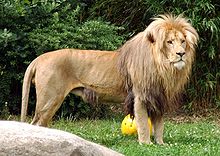Southwest African lion
| Southwest African lion | |
|---|---|

| |
| Southwest African lion in Etosha National Park, Namibia. | |

| |
| Southwest African lioness in Etosha National Park, Namibia. | |
| Scientific classification | |
| Kingdom: | |
| Phylum: | |
| Class: | |
| Order: | |
| Family: | |
| Genus: | |
| Species: | |
| Subspecies: | P. l. bleyenberghi
|
| Trinomial name | |
| Panthera leo bleyenberghi (Lönnberg, 1914)
| |
The Southwest African lion or Katanga lion (Panthera leo bleyenberghi) is a subspecies of the lion that lives in southwestern Africa. It is found in Namibia, Angola, Zaire, western Zambia, western Zimbabwe and northern Botswana. Besides the Southeast African lion, it is considered as the largest living lion subspecies, in the wilderness of Africa.[1][2][3] The type specimen was from Katanga (Zaire). Lions in the Kalahari xeric savanna may be either Panthera leo bleyenberghi or Panthera leo krugeri.[1] In 2008, surveys were conducted in the Upemba and Kundelungu National Parks located in the Democratic Republic of the Congo, but no evidence for the presence of lions was found.[4]
Physical characteristics
Males are around 2.5–3.10 metres (8.2–10.2 feet) long including the tail. Females are 2.3–2.65 metres (7.5–8.7 feet). The weight of males is generally 140–242 kg (308–533 pounds), and the females are 105–170 kg (231–378 pounds). They have a shoulder height of 0.90–1.20 metres (3.0–4.0 feet). Their manes tend to be lighter in color than those of other subspecies.[citation needed]
On record, the longest wild lion apparently was a male shot near Mucusso, southern Angola, in October 1973, which measured nearly 360 cm (11.8 ft) in total.[3] By comparison, the biggest Siberian tiger reportedly measured 350 cm (11.5 ft) "over the curves," or 330 cm (10.8 ft) "between the pegs,"[5] the heaviest Bengal tiger (388.7 kg (857 lb)) reportedly measured 338 cm (11.09 ft) "over the curves," or 322 cm (10.56 ft) "between the pegs,"[3] and the record for the Indian lion was 2.92 m (9.6 ft), including the tail (Sinha, 1987).[6]
Hunting and prey
Like other African lions, Katanga lions prey mostly on large animals, like zebras, wildebeest, antelope, and warthogs.[citation needed]
In captivity

A small captive population exists. There are 29 lions from this subspecies registered by the International Species Information System. These animals are derived from animals which were captured in Angola and Zimbabwe.[7]
However, the purity of these captive lions was not confirmed. Genetic analysis indicated that they could have been maternally derived from West or Central African lions, which appeared to be more closely related to North African and Asiatic lions than to other Sub-Saharan African lions.[8][9]
See also
- Cape lion
- Cecil (lion)
- East African lion
- Lady Liuwa
- Northeast Congo lion
- Kafue National Park
- Prishibinsk tiger
- Mucusso elephant
References
- ^ a b Haas, S.K.; Hayssen, V.; Krausman, P.R. (2005). "Panthera leo" (PDF). Mammalian Species. 762: 1–11. doi:10.1644/1545-1410(2005)762[0001:PL]2.0.CO;2.
- ^ Smuts, G.L.; Robinson, G.A.; Whyte, I.J. (1980). "Comparative growth of wild male and female lions (Panthera leo)". Journal of Zoology. 190 (3): 365–373. doi:10.1111/j.1469-7998.1980.tb01433.x.
- ^ a b c Wood, The Guinness Book of Animal Facts and Feats. Sterling Pub Co Inc (1983), ISBN 978-0-85112-235-9
- ^ http://www.bakasbl.org/news/doc_en/107.doc
- ^ Mazak, V. (2004). Der Tiger. Westarp Wissenschaften Hohenwarsleben. ISBN 3-89432-759-6.
- ^ Nowell, Kristin; Jackson, Peter (1996). "Panthera Leo". Wild Cats: Status Survey and Conservation Action Plan (PDF). Gland, Switzerland: IUCN/SSC Cat Specialist Group. pp. 17–21. ISBN 2-8317-0045-0.
- ^ Barnett, R.; Yamaguchi, N.; Barnes, I.; Cooper, A. (2006). "The origin, current diversity and future conservation of the modern lion (Panthera leo)". Proceedings of the Royal Society B: Biological Sciences. 273 (1598): 2119–25. doi:10.1098/rspb.2006.3555. PMC 1635511. PMID 16901830.
{{cite journal}}: Unknown parameter|last-author-amp=ignored (|name-list-style=suggested) (help) - ^ Bertola, L. D., van Hooft, W. F. Vrieling, K., Uit de Weerd, D. R., York, D. S., Bauer, H., Prins, H. H., Funston, P. J., Udo de Haes, H. A., Leirs, H., van Haeringen, W., A., Sogbohossou, E., Tumenta, P. N., de Iongh, H. H. (2011). "Genetic diversity, evolutionary history and implications for conservation of the lion (Panthera leo) in West and Central Africa". Journal of Biogeography. 38 (7): 1356. doi:10.1111/j.1365-2699.2011.02500.x.
{{cite journal}}: CS1 maint: multiple names: authors list (link) - ^ Antunes, A., Troyer, J. L., Roelke, M. E., Pecon-Slattery, J., Packer, C., Winterbach, C., Winterbach, H., Johnson, W. E. (2008). "The Evolutionary Dynamics of the Lion Panthera leo Revealed by Host and Viral Population Genomics". PLoS Genetics. 4 (11): e1000251. doi:10.1371/journal.pgen.1000251. PMC 2572142. PMID 18989457.
{{cite journal}}: CS1 maint: multiple names: authors list (link) CS1 maint: unflagged free DOI (link)
